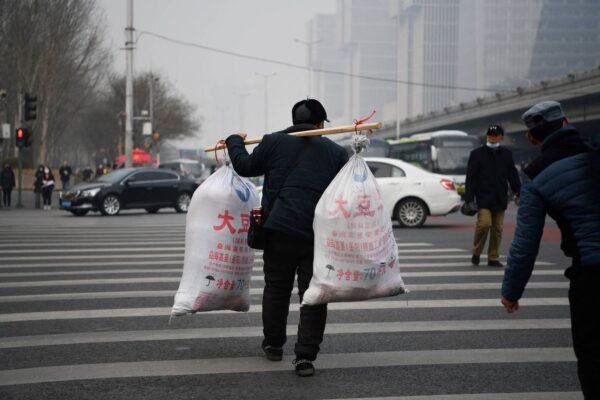News Analysis
The Chinese communist regime’s National Bureau of Statistics released new economic data for February on March 18, including a higher unemployment rate.
Experts say that the latest unemployment figures are “definitely concerning” as high unemployment affects consumption, sluggish consumption affects domestic demand, and insufficient domestic demand affects companies’ hiring.
Data from the Bureau of Statistics showed that the urban unemployment rate in February was 5.3 percent. This was the third consecutive month that the figure rose, from 5.1 percent in December last year to 5.2 percent in January and then to 5.3 percent in February, which brought the unemployment rate back to the level of last July.
In February, the unemployment rate of the 16 to 24-year-old labor force in urban areas nationwide was 15.3 percent, which excluded student groups; the unemployment rate of the 25 to 29-year-old labor force was 6.4 percent, and the unemployment rate of the labor force aged 30 to 59 was 4.2 percent. As observed by the outside world, the ruling Chinese Communist Party’s (CCP) official data often conceals unfavorable situations for its regime, and the actual data may be even worse.
In July last year, Chinese scholar Zhang Dandan, an associate professor at Peking University, stated in a research article that if the approximately 16 million young people who are doing nothing but mooching off their parents were considered unemployed, the actual youth unemployment rate in March last year would have been as high as 46.5 percent.
Li Hengqing, a U.S.-based political and economic scholar, told The Epoch Times on March 19 that the unemployment rate announced now finally reached 5.3 percent, “but this is useless. Because this is only the unemployment rate of the urban population, the vast rural areas are not covered.”
According to the CCP’s official data, the rural population accounts for more than 40 percent of China’s total 1.4 billion population.
Mr. Li said, “Rural areas are not counted at all, nor are migrant workers. Nowadays, a large number of people from the countryside go to the cities to look for work. They are totally disregarded, so 5.2 percent or 5.3 percent is not convincing at all.”

Henry Wu, a macroeconomics expert, pointed out that unemployment is one of China’s major economic problems.
He told The Epoch Times on March 19, “As for the unemployment crisis, the main reason is that China’s economic growth has lost momentum. Previously, China’s fast economic growth had provided enough employment opportunities for the large number of college graduates to find jobs. But the past records show that China’s GDP growth rate must be maintained at 6 percent for that to happen, which is an important threshold.”
Mr. Wu pointed out that the imbalance of China’s economic structure has not been properly dealt with, because it has relied on exports for too long, relied on foreign demand for too long, and domestic demand has not developed. “They need to create jobs from the demand side, creating new industries and new orders, etc. Only in this way can they sustain the development of job opportunities in the long term.”Official data released on Monday also showed that real estate investment fell 9 percent compared with the same period last year. Although the decline once exceeded 20 percent in December last year and has slowed down since then, the sales of new homes still fell by 24.1 percent in February, showing that the decline of the real estate industry remains the main obstacle affecting China’s economic recovery.

The outside world has been questioning the official economic data released by the CCP due to the regime’s lack of transparency.
Mr. Li said that the CCP leader Xi Jinping already knew that whatever he did was useless and that China’s economy was hopeless, but he still wanted to save it. “Because there is a particularly big problem now. The economic performance determines the legitimacy of the CCP’s governance. One is the legitimacy of the CCP, and the other is the legitimacy of whether Xi can continue to be in power. This has become his biggest challenge.”
“So they just follow the method of falsification, bragging about China’s economy. Wang Huning (Xi’s top advisor), Xinhua News Agency, and all agencies are singing praises. All official media must follow.”
Mr. Wu also pointed out that “whether the data is true or false is no longer worth talking about, because the economic data officially released by the CCP, from GDP growth rate to other data, are no longer reliable, and it is meaningless to talk about it. Therefore, people should judge and interpret the economic situation and disregard the official data.”
Mr. Wu suggested, “If you really want to look at it [the Chinese economy], it’s very simple: just use two places as indicators, Shanghai and Shenzhen. Shenzhen is the manufacturing center, and Shanghai is the center for the service industry, financial industry, and shipping. You go to the stores, restaurants, and places frequented by consumers in these two cities and see if there is any depression. This is called field research.”
“You can also tell the local business activities from the market conditions of commercial office buildings in these cities. If you take a look and make a comparison, you will know whether the economic situation is getting better or worse,” he said.
Luo Ya and Cheng Jing contributed to this report.

